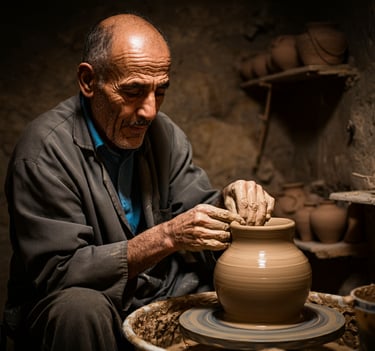Moroccan Pottery: A Legacy of Art and Tradition
CULTURE & HERITAGE


Pottery is among the oldest and most important crafts in Moroccan culture, originating from the ancient civilizations that once populated the area. For thousands of years, Morocco's history has intricately woven this ancient art form, evolving through numerous dynasties and reflecting the nation's rich cultural diversity. Both practical and decorative ceramic forms are significant in Moroccan culture, symbolizing heritage, artistic expression, and cultural identity. This article will examine the origins of pottery in Morocco, its development through many dynasties, and its lasting significance in modern Moroccan culture.
The Origin of Pottery in Morocco
The indigenous Berber populace, who have been in the area for millennia, may have originated pottery in Morocco. Early Berber pottery was mostly utilitarian, fulfilling common functions such as cooking, water storage, and food preservation. Berber craftsmen at that period demonstrated their proficiency by firing these first ceramic artifacts, constructed from indigenous clay, in rudimentary kilns.
As Morocco emerged as a hub of commerce and cultural interchange, the methodologies and aesthetics of pottery production evolved in sophistication. The entrance of the Phoenicians and Carthaginians, followed by the Romans, introduced new influences and techniques that influenced the evolution of Moroccan pottery. Roman potters notably pioneered sophisticated glazing methods and high-temperature kilns, establishing a foundation for more elaborate and refined ceramic manufacturing in the area. Native Berber workmanship integrated foreign influences, resulting in a distinctive amalgamation of styles that subsequently characterized Moroccan ceramics.
Ceramics Throughout Moroccan Dynasties
Throughout Morocco's history, pottery underwent substantial evolution due to the influence of many governing dynasties. Every age has influenced the craft, adding new forms, methods, and cultural importance to Moroccan ceramics.
Islamic Impact During the Idrisid Dynasty (8th–9th Century)
The evolution of Moroccan pottery started under the Idrisid Dynasty when Islamic influences began to mold the region's art and culture. Geometric patterns, floral themes, and calligraphic designs typical of Islamic art were prevalent in Moroccan ceramics. During this period, Fez, a city destined to become a prominent center for pottery manufacture, developed into a nexus for ceramic artistry. The complex patterns and symbolic themes of this period established the groundwork for the creative development of Moroccan ceramics.
The Almoravid and Almohad Dynasties (11th–13th Centuries)
The Almoravid and Almohad dynasties saw a flourishing of Moroccan pottery as artists delved into intricate designs and vivid color schemes. During this period, pottery fulfilled both functional and ornamental roles with enormous tiles manufactured to embellish the walls of mosques, palaces, and public edifices. This period signified a notable progression in Moroccan ceramics, transforming it from a utilitarian craft into a vehicle for creative expression. Pottery from this era often had intricate geometric designs, mirroring the overarching creative movements of the Islamic realm but integrating distinct Moroccan characteristics.
The Saadian Dynasty (16th–17th Centuries)
The Saadian Dynasty was a prosperous period for Moroccan ceramics, especially in Safi, which gained fame for its distinctive ceramic traditions. Safi pottery, characterized by its vivid colors—particularly the renowned cobalt blue—and elaborate designs, achieved significant acclaim both in Morocco and elsewhere. The Saadians patronized the arts, resulting in heightened creative complexity in Moroccan ceramics, which became highly coveted by merchants and collectors. The city's proximity to clay-abundant areas allowed Safi to maintain its status as a significant hub for pottery manufacturing.
The Alaouite Dynasty (17th Century–Present)
During the Alaouite Dynasty, Moroccan pottery progressed, incorporating elements from Spain, France, and sub-Saharan Africa. This century, the intricate zellige tilework, made of tiny, hand-cut ceramic tiles, emerged as a defining feature of Moroccan architecture. This elaborate artistry demonstrates the profound expertise and talent of Moroccan potters, who have successfully maintained ancient methods while integrating innovative concepts. The Alaouites maintained royal sponsorship for pottery and the arts, guaranteeing the preservation and advancement of Moroccan ceramics throughout the years.
Pottery in Morocco: Modern Cultural Significance
In contemporary Morocco, pottery continues to be a dynamic and essential component of the nation's creative heritage. Moroccans regard pottery not only as a craft but also as a means of preserving their cultural history. Generations of craftsmen perpetuate traditional Ceramics in Everyday Life
The beautiful allure of Moroccan ceramics is indisputable; however, their use in daily life is as important. A quintessential example of practical pottery in Morocco is the tagine, a conical clay cooking vessel integral to Moroccan cuisine. The tagine* serves to prepare a diverse array of foods with both practical and symbolic significance, representing the profound connection between food, family, and tradition in Moroccan society.
Furthermore, ceramic containers for storing water, oils, and grains persist in rural regions, illustrating the ongoing practicality of pottery in Moroccan homes. Cultural traditions intricately link the practical applications, ensuring pottery's continued vitality in Morocco's cultural environment.
Cultural and artistic expression
Moroccan ceramics' elaborate patterns and vibrant hues profoundly connect to the country's cultural character. Pottery sometimes incorporates symbolic designs, including geometric forms that signify the limitless essence of creation and floral themes that reflect the beauty of the natural world. These patterns transcend conventional ornamentation; they have cultural and spiritual importance, linking Moroccan artists to their ancient history.
Contemporary Moroccan potters advance their art by integrating traditional methods with modern aesthetics, producing works that attract both domestic and global markets. Globally, Moroccan pottery holds great artistic value, symbolizing the nation's profound cultural heritage and inventive essence.
Pottery serves as a means of economic empowerment.
Pottery serves as both an artistic expression and a crucial means of subsistence for several Moroccans, particularly in rural regions. Workshops and cooperatives, most of which employ women, are essential for the preservation of pottery-making traditions as well as for providing economic opportunities to local communities. These cooperatives often manufacture ceramics for both local use and export, therefore preserving the craft and guaranteeing equitable remuneration for craftsmen.
The worldwide demand for Moroccan ceramics has enhanced its economic importance. Moroccan ceramics are in high demand among collectors, designers, and visitors, who appreciate the artistry and cultural authenticity of these items. Consequently, the craft has become an essential component of Morocco’s artisanal sector, generating income for several families.
Summary
The progression of Moroccan pottery from its modest origins to its esteemed recognition as an art form exemplifies the nation's profound cultural legacy. Throughout the years, Moroccan pottery has seen considerable modifications, shaped by many kingdoms and exterior cultures. Nevertheless, it has remained profoundly entrenched in the Berber traditions from where it originated. Currently, Moroccan pottery flourishes, symbolizing both the creativity and perseverance of its craftsmen and the lasting cultural pride of the Moroccan populace. By maintaining ancient methods and investigating new artistic avenues, Moroccan pottery continues to embody the nation's creative essence and cultural identity.
